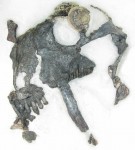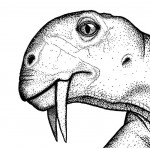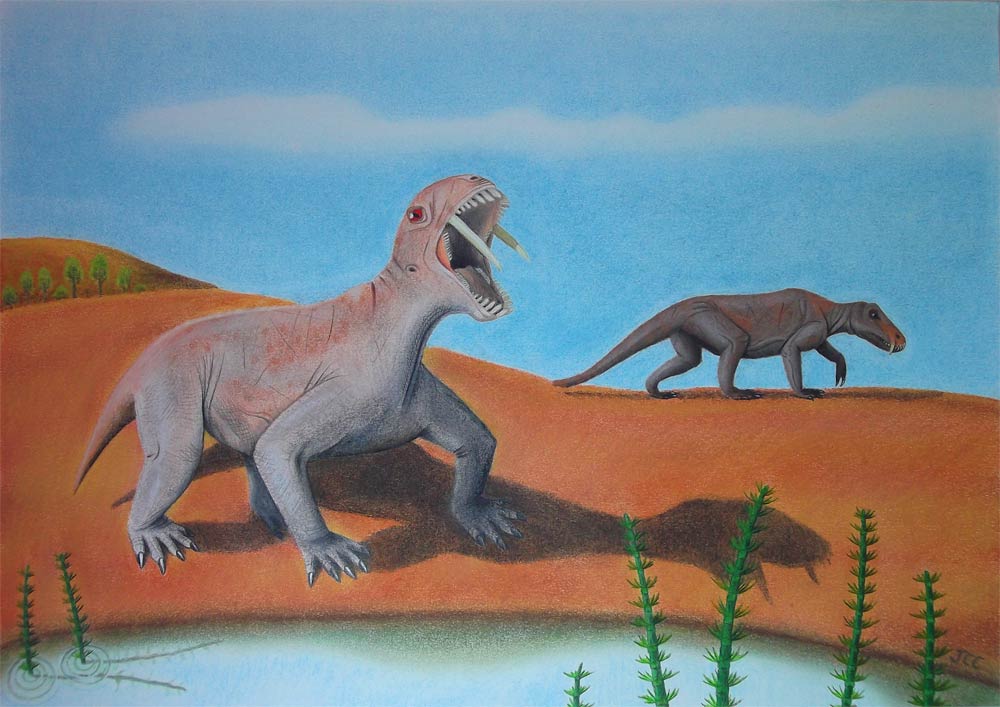 Paleontologists in Tiarajú, southern Brazil, have discovered the fossil of a new species: a plant-eater about the size of a large dog with 5-inch long canines jutting down over its lower jaw. Not only did the 260 million-year-old critter have saber teeth despite its exclusively vegetarian diet, but the entire roof of its mouth was covered with teeth, probably for ready replacement of old ones similar to how sharks have rows of backup teeth.
Paleontologists in Tiarajú, southern Brazil, have discovered the fossil of a new species: a plant-eater about the size of a large dog with 5-inch long canines jutting down over its lower jaw. Not only did the 260 million-year-old critter have saber teeth despite its exclusively vegetarian diet, but the entire roof of its mouth was covered with teeth, probably for ready replacement of old ones similar to how sharks have rows of backup teeth.
Scientists have named it Tiarajudens eccentricus — “Tiarajú” because it was found there, “dens” for “teeth,” and “eccentricus” for “eccentric” on account of its unusual and unexpected combination of features.
“If you asked me how surprised I was about finding this fossil, I can tell you that finding a fossil so bizarre as Tiarajudens eccentricus, a fossil that looks like if it has been made from parts of different animals, is like finding a unicorn,” vertebrate paleontologist Juan Carlos Cisneros at the Federal University of Piauí in Teresina, Brazil, told LiveScience. “You see it, but you don’t believe it.”
This animal was a kind of anomodont, the most abundant four-legged creatures of the Permian, the 50-million-year-long period right before the age of dinosaurs. Anomodonts belonged to a group known as therapsids, which gave rise to modern mammals.
It’s the first therapsid found whose top and bottom teeth fit together like ours. That makes for highly efficient chewing to help grind up the fibrous plants and stems of Permian Brazil.
 The saber teeth would not have been used for chewing, however. They were in all likelihood weapons used to protect against predators and spar with competitors, much how modern male deer use their antlers. Since scientists thought the sparring behavior was introduced by modern animals, finding a herbivore with sparring weapons from 260 million years ago when therapsids first appear in the fossil record rewrites evolutionary history.
The saber teeth would not have been used for chewing, however. They were in all likelihood weapons used to protect against predators and spar with competitors, much how modern male deer use their antlers. Since scientists thought the sparring behavior was introduced by modern animals, finding a herbivore with sparring weapons from 260 million years ago when therapsids first appear in the fossil record rewrites evolutionary history.
Interesting technological side-note: scientists found this site using Google Earth. The area today is blanketed in dense vegetation, so researchers would be working blind if they hadn’t had satellite pictures showing in detail erosion patterns and colors of the stone. The erosion indicates which areas might have more fossils nearer the surface, and the colors indicate the different ages of the stone. They looked for well-eroded Permian-colored stone and they found them a saber-toothed pigturtle.

Is there anything Google can’t do?
Other than pushing toothpaste back into the tube, no.
:love:
I totally want a pygmy sabre-toothed vegetablarian dinosaur.
Me first!
That is almost as cool as Megatherium!
That’s a bold statement coming from you. 😮
That’s really awesome!
Reminds me a bit of the little tusks of the Muntjacs :love:
Ooh, excellent call. Muntjacs are the oldest modern deer species, and mammals are descended from therapsids, so they may not be that far apart.
Could the teeth have been used for digging up roots and tubers?
I’m not sure, but I doubt it. The curvature of the sabers would make the neck movement needed to dig with them awkward, it seems to me. That’s pure speculation, though.
google is awsomeee …. just think abt all the information produced ..on this single page :no: ..its so unbelieveable
[i]”They looked for well-eroded Permian-colored stone and they found them a saber-toothed pigturtle.”[/i]
ROFLMAO!!!